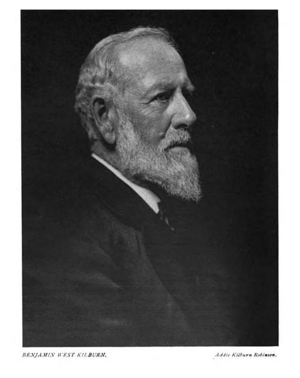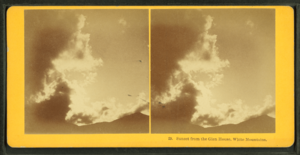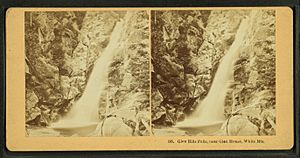Benjamin W. Kilburn facts for kids
Quick facts for kids
Benjamin West Kilburn
|
|
|---|---|

Kilburn c. 1897
|
|
| Born | December 10, 1827 |
| Died | January 15, 1909 (aged 81) |
| Resting place | Littleton, NH Cemetery |
| Occupation | Photographer |
| Known for | "Old Man of the Mountain" (stereo-photograph of Cannon Mountain in Franconia Notch, White Mountains, New Hampshire) |
Benjamin West Kilburn (born December 10, 1827 – died January 15, 1909) was a famous American photographer. He was known for taking amazing pictures of landscapes. Many of his photos showed new parks in America and Canada. He also captured images of people moving across the country in the late 1800s. Kilburn was even a lawmaker in New Hampshire. He invented a special camera that looked like a gun!
Contents
Who Was Benjamin Kilburn?
Benjamin's father, Josiah Kilburn, made iron stoves. At age 16, Benjamin learned to be a machinist in Fall River, Massachusetts. Four years later, he returned to Littleton, New Hampshire. There, he joined his father's business, Josiah Kilburn & Son foundry.
Kilburn was a sergeant in the 13th New Hampshire Volunteer Infantry. He fought with his unit in the Civil War at the Battle of Fredericksburg in Virginia.
Benjamin Kilburn loved climbing mountains. He explored Mount Washington in New Hampshire. He also climbed in Ouray, Colorado, and the Sierra Nevada in California. This included Yosemite in 1872.
How Did Kilburn Start Photography?
The first "Kilburn Brothers" stereo photos appeared around 1865. Stereo photos are special pictures that look 3D when viewed with a special device. People believe Benjamin took all the stereo photos before 1876. His brother, Edward Kilburn (born 1830 – died 1884), learned photography earlier. He was taught by Ora C. Bolton, a local daguerreotypist from Waterford, Vermont.
Another photographer, O. C. Bolton, also taught Franklin G. Weller. Weller was from Littleton, New Hampshire. He became a well-known stereo photographer. Weller created funny pictures and started a popular trend. This trend later appeared in Kilburn's photo collections. Bolton also knew Franklin L. White, an early stereo photographer from Lancaster, New Hampshire. White published a list of his glass stereo photos in 1859.
Early Kilburn stereo photos were sold by Joseph L. Bates. This store specialized in Oliver Wendell Holmes stereo viewers. Bates's store was on Washington Street in Boston. A catalog of Kilburn-Bates stereo photos was published around 1867. The photos listed by Kilburn were similar to those by Franklin L. White. Bates's support helped Kilburn Brothers become popular in the market.
The Kilburn Brothers Business



The first stereo photos were made in Edward Kilburn's studio in Littleton. The business grew quickly and needed more space. The company stayed a family business. It focused on local scenes and local artists. Benjamin's daughter, Elizabeth, and her husband, William Jackson, worked there. They helped make the Kilburn photos high quality.
By 1868, a second, larger studio was built on Main Street. After that, a new factory was built on Cottage Street. This factory had even more room to grow. Both of these larger studios were close to the Littleton train station. Young salespeople carried Kilburn photos onto trains. They traveled south to reach more and more customers. Today, the site of the third studio is a state historic landmark. The company quickly became the world's largest maker of stereo photos.
Edward Kilburn left the partnership around 1877. However, the photos were still called "Kilburn Brothers" until the late 1880s. John P. Soule, a famous stereo photographer from Boston, worked closely with the Kilburn Brothers. Many of his photo negatives were sent to the Kilburn business in Littleton in 1881. Benjamin was also active in the National Photographic Association.
The new B. W. Kilburn & Company brought many changes. By 1890, Benjamin's second son-in-law, Daniel Clark Remich, joined the company's board. James M. Davis also joined. He managed a growing team of door-to-door salespeople. Later, Davis would manage the company's daily operations. He was based first in Philadelphia, then in New York and St. Louis. He used his special "Artistic" cable address to manage photo production. He sent photographers to faraway places and hired people to sell the photos.
The Columbian Exposition (World's Fair) in Chicago in 1893 was a huge success for their business. They got the special right to sell stereo photos of the World's Fair.
Later, other companies took over the business. These included W. F. Burns & Co. in 1910, Underwood & Underwood brothers, and B. L. Singley of the Keystone View Company.
Kilburn's Lasting Impact
Benjamin W. Kilburn is remembered for two main things. First, he was a visual historian. He documented immigration and international tourism through his photos. Second, his company was the world's largest maker of stereo photos from 1865 to 1910. He was a pioneer in photojournalism. This means he used photos to tell news stories. He photographed the presidential inauguration of Grover Cleveland. He also covered the Johnstown Flood in Pennsylvania, the Boer War, the Boxer Rebellion, and the Spanish–American War.
Kilburn also invented a photo gun camera. This camera was made by Scovill Mfg. Co. from 1882 to 1886. It helped photographers take pictures without using a tripod. This was especially helpful when taking photos in the White Mountains, New Hampshire.
Benjamin Kilburn was a good citizen. He was a veteran of the American Civil War and supported the Grand Army of the Republic. He also helped develop early fire-fighting equipment. He was involved in search and rescue missions on Mount Washington.


